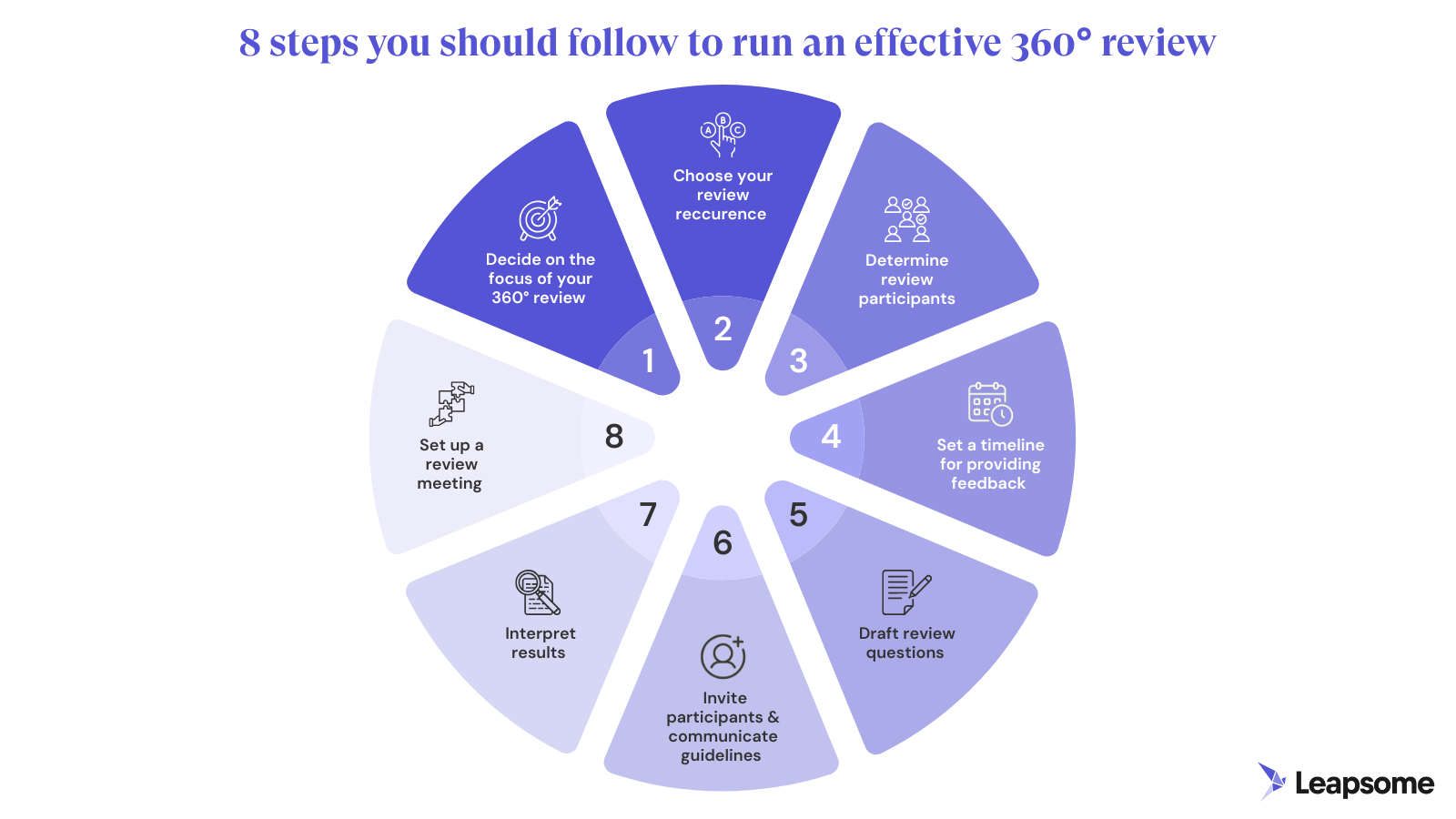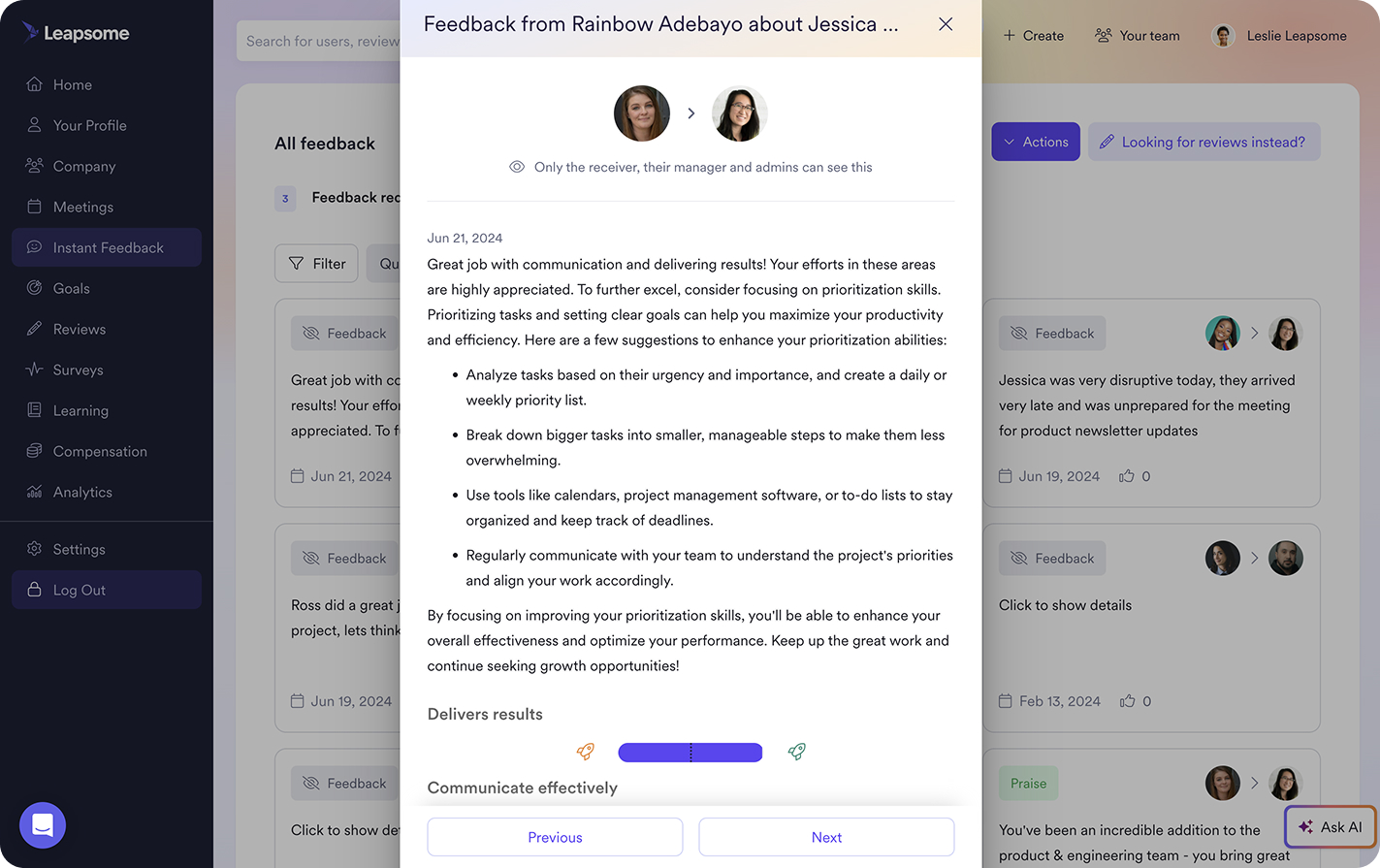
TL;DR A 360-degree review involves self-evaluations and performance assessments from an employee’s own manager, peers, reports (if applicable), and sometimes, additional collaborators. This holistic approach to performance reviews aims to provide a well-rounded perspective on an employee's strengths and areas for development.
In this playbook, we’ll cover best practices, key priorities, and essential tools for implementing 360-degree reviews.

360° performance reviews are a performance management framework in which employees receive feedback from multiple sources:
This multi-source feedback allows employees to gain a deeper understanding of how their performance is perceived across different relationships, leading to more balanced and actionable insights.
By incorporating diverse perspectives, 360° reviews help mitigate the effects of unconscious bias, making evaluations fairer and more development-focused.
To streamline the 360-degree review process, you can leverage AI-powered software like Leapsome Reviews. With intuitive automation, ready-to-use templates, and centralized performance data, it reduces admin workload while improving the quality of feedback. Leapsome’s user-friendly interface encourages participation and ensures more accurate, constructive insights from all reviewers.
😁 Make 360-degree reviews simple & effective
Get started with 360-degree reviews quickly with best-practice templates, a question bank, and built-in analytics.
👉 Learn more about Leapsome Reviews
This playbook is ideal for leaders and managers aiming to:
If your organization is experiencing lower employee satisfaction or increased turnover, implementing a 360° review process can be a valuable component of your employee engagement initiatives.
Your values are great guides for the 360° review process and can help assess alignment with your goals. Still, even companies with a fully articulated values system struggle to connect values to the employee’s specific sense of purpose at work.
Executive coach Sarah Furness recommends developing a single-sentence mission statement that can be applied to both macro and micro business scenarios. She suggests asking yourself: “What’s the single most important thing this company was put on Earth to do?”
Your employees need to know that you won’t use 360s to penalize them. Be clear that the goal of 360° reviews is to help team members develop and grow.
Also, ensure they understand why you’re asking multiple sources to provide feedback and explain the reasoning behind your review cycle frequency.
Make sure you have a solid system to analyze and track growth. A platform like Leapsome Reviews can greatly streamline the 360° review process, allowing for review cycle automation and access to analytics dashboards to monitor long-term trends in employee development.

Each review cycle should serve a clear purpose to ensure feedback is meaningful and actionable. HR managers and team leads should define specific competencies, behaviors, or goals relevant to the employee’s role and organizational objectives — and these should guide the performance review and the employee’s development plans.
For instance, a probation period review may focus on assessing how well the employee is ramping up in their new role and discussing what they need to integrate and develop.
However, a senior manager’s mid-year review would likely look very different, assessing strategic decision-making and leadership competencies.
A well-timed review cadence ensures ongoing development without overwhelming employees. According to our Workforce Trends Report, roughly four in five employees agree that performance reviews are helpful — and many want them to happen more often. While quarterly or biannual reviews are common, consider your company’s needs.
Frequent check-ins help maintain momentum and give more opportunities to readjust personal development plans, while annual reviews may suit organizations with particularly stable roles and responsibilities.
As mentioned, 360° review reviews traditionally involve a:
You’ll need to carefully consider whose feedback will make the most impact and be most relevant for the employee being reviewed.
Ask yourself these questions to get more clarity about who should take part:
Establish a structured timeline to prevent delays and ensure thorough, thoughtful feedback.
A common practice is to allocate one to two weeks for collecting responses, allowing participants time to reflect and provide detailed input.
⭐ Take the manual work out of 360° performance reviews
Automate assessment cycles with Leapsome Reviews to stay on top of evaluations and track progress.
👉 Book a demo

Ensure every team member has relevant data to answer the questions meaningfully.
For example, if asking: “What is the most important development goal [x employee] should work on?” make sure respondents have access to your organization’s competency frameworks. That way, they’ll be able to assess team members fairly based on established competencies that are used for all employees in the same or similar roles.
Here are a few example questions for 360° reviews:
You should also include a few of these role-specific questions and define which ones are relevant to each perspective:
💡 Best practice: Keep reviews 15-20 questions max to prevent fatigue.
⭐ Make feedback actionable & constructive
Use our free 360° review template and empower everyone at your workplace to give more positive, insightful input that moves your organization forward.
👉 Download the free template
Create a centralized feedback form for all reviewers so you don’t risk any assessments falling through the cracks.
To encourage meaningful participation, reinforce the importance of constructive feedback, and consider sharing the guidelines below:
💡 Looking to improve your entire performance management cycle?
Our free, downloadable 1:1 meetings template is the perfect resource to make your check-ins more productive and actionable.

This is arguably the most intimidating part for managers, but it doesn’t have to be. Platforms like Leapsome leverage AI to summarize review data for you — and even build out the next steps based on feedback.
When you’re analyzing the results, make sure you keep these practices in mind:
The manager and reviewee should now schedule a meeting to discuss the feedback. The focus on development should be top of mind — and that should also include reinforcing strengths the reviewee already has. Unlike traditional performance reviews, modern 360° reviews are about growing together and focusing on the future.
Follow this meeting agenda template if it’s your first time going through review results with a direct report:
💡 Interested in learning more about feedback and reviews?
We’ve got you covered: Check out our free template with best-practice questions for performance reviews — including specific questions for 360° and leadership reviews — and 25 smart questions to ask in performance reviews.
And how about offering your employees even more support when it’s time for their 360° performance review? See our guide and infographic on how to write a self-assessment for your next performance review. 😉
Because feedback comes from multiple perspectives, a 360° review gives you a more complete view and helps you spot discrepancies, patterns, and areas to improve. But to get the most value out of the process, make it easy for all the stakeholders involved and track its impact, adjusting when it doesn’t fit everyone’s needs.
Many organizational leaders expect managers to champion their feedback culture, yet they don’t set them up for success. Recent Gallup data shows that only 48% of managers agree they have the skills and training they need to excel in their work.
Many managers need more clarity around performance appraisals and professional development, which companies can provide by:
One of the best ways to empower team members to track their progress is to have direct reports schedule weekly or biweekly check-ins and 1:1 meetings with their manager. While it’s great to keep these meeting agendas flexible, we suggest you:

If your employees are feeling disillusioned with the traditional review process, implementing 360° performance evaluations is a great way to bring them more balance, fairness, and diverse input.
However, if you want to truly transform your feedback culture, you need a platform like Leapsome. With our Reviews tool, you’ll have access to best-practice templates that make it easy to set up and automate your 360° review cycle. Managers and HR professionals can also track employee performance across specific skills and competencies with our built-in development matrix.
Leapsome Reviews is also powered by AI, which means you can quickly transform evaluation notes into unbiased comments and action-oriented suggestions and learn to give better feedback in the process.
Your people deserve well-rounded performance reviews that help them grow as professionals — and Leapsome can help deliver them with ease.
⭐ Create a five-star review experience
Ready to make your evaluations fairer and more development-focused? We have the templates, questions, automations, and analytics to get you there.
👉 Book a demo

Learn how Leapsome can automate, connect, and simplify your HR processes.
.webp)
.webp)
 Book your demo
Book your demo


Run smooth operations with our easy-to-follow how-tos and best practices for all things People Ops
Mit unseren leicht verständlichen Anleitungen und Best Practices für People Ops sorgen Sie für reibungslose Abläufe.